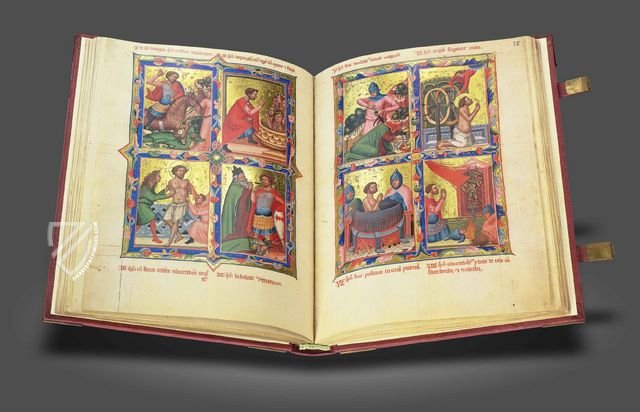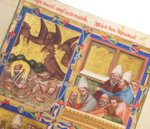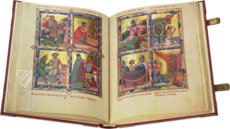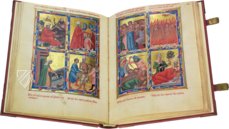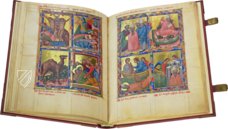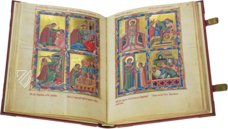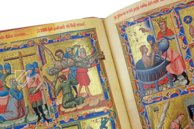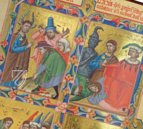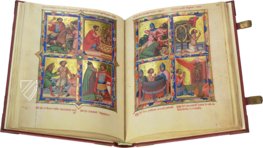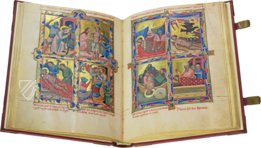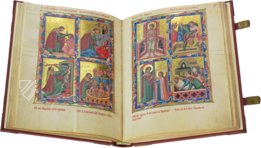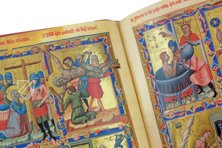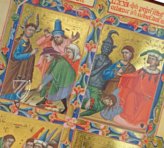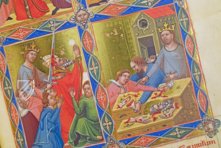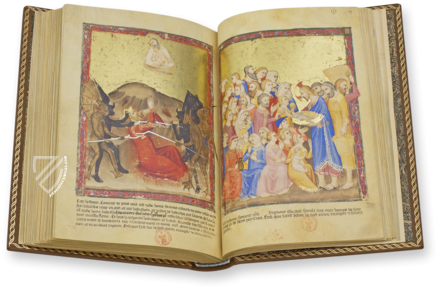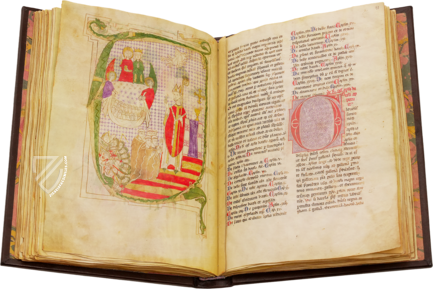Legenda Aurea - Anjou Legendarium
(1,000€ - 3,000€)
A gold-decorated Gothic masterpiece by an Italian master, created at the Hungarian royal court: the Legenda Aurea from Hungary originated around 1330 and was commissioned by the Hungarian King Charles I (1288-1342) as a gift to his son. The precious manuscript contains 105 vivid full-page miniatures, all of which set their scenes against a shimmering gold background and depict stories from the lives of important saints in vibrant colors. The codex is an enlargement of the work of the same name by Jacobus de Vorraigne (1228/9-1298) and focuses in particular on saints associated with the Anjou family as well as high-ranking church officials from Hungary and Poland. Each miniature page is divided into four sections, which are separated from each other by ornate framings. Some stylistic subtleties of the Gothic work already hint at the emerging Renaissance and make it a true gem of late medieval book illumination.
Legenda Aurea - Anjou Legendarium
Around 1330, King Charles I of Hungary, known as Charles Robert of the House of Anjou, commissioned a manuscript for his three year old son Andrew. The manuscript was an enlargement of the famous Legenda Aurea by the Dominican monk Jacobus de Vorraigne. It deals with a collection of saints’ lives and deeds. As a result, the Hungarian Legendarium places particular emphasis on people who had a special meaning for the Anjou family. A splendid picture cycle of 105 mostly full-page miniatures on a gold background illustrates the valuable manuscript.
A Picture Book for the Prince
The Legenda Aurea is a picture book intended for children, in which short texts describe the scenes depicted in the book. Early on, King Charles I of Hungary wanted his son to be familiarized with the legends of the saints, whom were associated with the Anjou family. Scenes are depicted from the lives of important biblical figures from various epochs. Among them are apostles and martyrs, monks, the Virgin Mary, but also high church officials from Hungary and Poland.
A Gothic Masterpiece
The qualitatively valuable miniatures probably originate from an important Late Gothic studio. The page-filling miniatures are separated into four scenes, respectively, that are framed by excitingly-patterned bordures. The dramatic and elegant miniatures on golden backgrounds shine in a vivid variety of luminous colors. Who exactly illustrated the codex is not knowable today. Nevertheless, the master was probably from Bologna, the school of painting of the so-called Trecento, the style that preceded the Renaissance. The miniatures of the Hungarian Legendarium show stylistic elements of naive Gothic painting and are already characterized by stylistically-changing influences of the Renaissance.
A World-Famous Book Treasure
The Legenda Aurea from Hungary, with its splendidly-colored miniatures, which are sometimes decorated with elaborately wrought golden backgrounds, is a fine specimen of Gothic book art. The work was divided into several parts and are to be found today in some of the most renowned libraries worldwide. The main part of the manuscript is housed in the Vatican Library. 20 miniatures are in the Morgan Library in New York. Five further pages are located in the Hermitage Museum in St. Petersburg.
Codicology
- Alternative Titles
- Heiligenleben
Ungarisches Legendarium
Legendarium der ungarischen Anjou
Legenda Aurea - Goldenes Legendarium
Golden Legend
Vitae Sanctorum
Hungarian Angevin Legendary
Legendario Angioino Ungherese
Legendar der Anjou
Vite dei Santi - Size / Format
- 212 pages / 28.0 × 21.5 cm
- Origin
- Hungary
- Date
- Ca. 1330–1340
- Epochs
- Style
- Genre
- Language
- Script
- Gothic
- Illustrations
- 105 mostly full-page miniatures (each page with 4 scenes) illuminated in gold
- Content
- Scenes from the lives of important saints based on the Legenda Aurea
- Patron
- King Charles I of Hungary (1288–1342)
- Artist / School
- Master of the Hungarian Legendary
Bolognese school - Previous Owners
- Charles' son Prince Andrew, Duke of Calabria (1327–1345)
Gian Battista Saluzzo
Legenda Aurea - Anjou Legendarium
Saint Ladislaus in Battle
Ladislaus I of Hungary was a chivalrous 11th century king who fought various battles in Transylvania against the Pechenegs and Cumans – nomadic Turkic horse archers from the steppes. A popular subject in Hungarian murals and manuscripts between the 14th and 16th centuries, the canonized king is shown here in battle against the invading heathens. As arrows fly through the air, Saint Ladislaus charges headlong against his enemies, who are characterized by oriental swords, headgear, and facial hair.
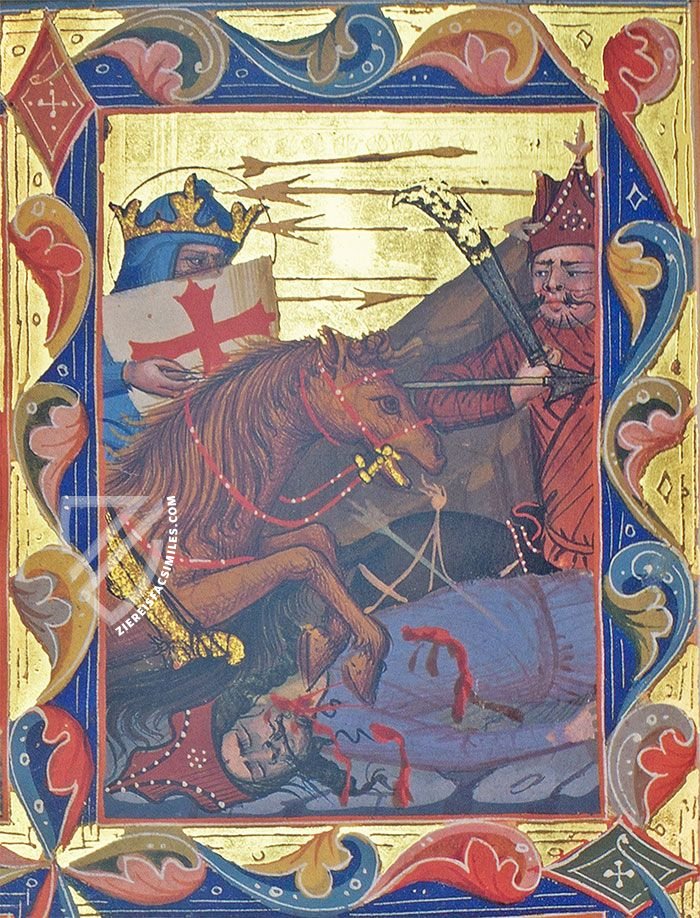
Legenda Aurea - Anjou Legendarium
Martyrdom of Saint Peter
The Pope is often referred to as the “heir of St. Peter”, an Apostle who was martyred in Rome in the year 64, which is illustrated here. The cause is debated: some claim that it was part of recriminations against Christians who were blamed for the Great Fire of Rome, others claim it was simply because of his faith.
Peter is depicted with his iconic short-cropped beard and balding head in this gorgeous, richly gilded miniature. He is arrested and crucified on the orders of the Emperor Nero, who is depicted as a bearded medieval king. This was done with his head downward according to his own wishes, because he felt unworthy to die in the same way as Christ. The final scene, in which his body is wrapped, features a figure wearing a miter, an allusion to the papacy?

#1 Heiligenleben - Legendarium der ungarischen Anjou
Language: German
(1,000€ - 3,000€)
- Treatises / Secular Books
- Apocalypses / Beatus
- Astronomy / Astrology
- Bestiaries
- Bibles / Gospels
- Chronicles / History / Law
- Geography / Maps
- Saints' Lives
- Islam / Oriental
- Judaism / Hebrew
- Single Leaf Collections
- Leonardo da Vinci
- Literature / Poetry
- Liturgical Manuscripts
- Medicine / Botany / Alchemy
- Music
- Mythology / Prophecies
- Psalters
- Other Religious Books
- Games / Hunting
- Private Devotion Books
- Other Genres
- Afghanistan
- Armenia
- Austria
- Belgium
- Belize
- Bosnia and Herzegovina
- China
- Colombia
- Costa Rica
- Croatia
- Cyprus
- Czech Republic
- Denmark
- Egypt
- El Salvador
- Ethiopia
- France
- Germany
- Greece
- Guatemala
- Honduras
- Hungary
- India
- Iran
- Iraq
- Israel
- Italy
- Japan
- Jordan
- Kazakhstan
- Kyrgyzstan
- Lebanon
- Liechtenstein
- Luxembourg
- Mexico
- Morocco
- Netherlands
- Palestine
- Panama
- Peru
- Poland
- Portugal
- Romania
- Russia
- Serbia
- Spain
- Sri Lanka
- Sweden
- Switzerland
- Syria
- Tajikistan
- Turkey
- Turkmenistan
- Ukraine
- United Kingdom
- United States
- Uzbekistan
- Vatican City
- A. Oosthoek, van Holkema & Warendorf
- Aboca Museum
- Ajuntament de Valencia
- Akademie Verlag
- Akademische Druck- u. Verlagsanstalt (ADEVA)
- Aldo Ausilio Editore - Bottega d’Erasmo
- Alecto Historical Editions
- Alkuin Verlag
- Almqvist & Wiksell
- Amilcare Pizzi
- Andreas & Andreas Verlagsbuchhandlung
- Archa 90
- Archiv Verlag
- Archivi Edizioni
- Arnold Verlag
- ARS
- Ars Magna
- ArtCodex
- AyN Ediciones
- Azimuth Editions
- Badenia Verlag
- Bärenreiter-Verlag
- Belser Verlag
- Belser Verlag / WK Wertkontor
- Benziger Verlag
- Bernardinum Wydawnictwo
- BiblioGemma
- Biblioteca Apostolica Vaticana (Vaticanstadt, Vaticanstadt)
- Bibliotheca Palatina Faksimile Verlag
- Bibliotheca Rara
- Boydell & Brewer
- Bramante Edizioni
- Bredius Genootschap
- Brepols Publishers
- British Library
- C. Weckesser
- Caixa Catalunya
- Canesi
- CAPSA, Ars Scriptoria
- Caratzas Brothers, Publishers
- Carus Verlag
- Casamassima Libri
- Centrum Cartographie Verlag GmbH
- Chavane Verlag
- Christian Brandstätter Verlag
- Circulo Cientifico
- Club Bibliófilo Versol
- Club du Livre
- CM Editores
- Collegium Graphicum
- Collezione Apocrifa Da Vinci
- Comissão Nacional para as Comemorações dos Descobrimentos Portugueses
- Coron Verlag
- Corvina
- CTHS
- D. S. Brewer
- Damon
- De Agostini/UTET
- De Nederlandsche Boekhandel
- De Schutter
- Deuschle & Stemmle
- Deutscher Verlag für Kunstwissenschaft
- DIAMM
- Droz
- E. Schreiber Graphische Kunstanstalten
- Ediciones Boreal
- Ediciones Grial
- Ediclube
- Edições Inapa
- Edilan
- Editalia
- Edition Deuschle
- Edition Georg Popp
- Edition Leipzig
- Edition Libri Illustri
- Editiones Reales Sitios S. L.
- Éditions de l'Oiseau Lyre
- Editions Medicina Rara
- Editorial Casariego
- Editorial Mintzoa
- Editrice Antenore
- Editrice Velar
- Edizioni Edison
- Egeria, S.L.
- Eikon Editores
- Electa
- Emery Walker Limited
- Enciclopèdia Catalana
- Eos-Verlag
- Ephesus Publishing
- Ernst Battenberg
- Eugrammia Press
- Extraordinary Editions
- Fackelverlag
- Facsimila Art & Edition
- Facsimile Editions Ltd.
- Facsimilia Art & Edition Ebert KG
- Faksimile Verlag
- Feuermann Verlag
- Folger Shakespeare Library
- Franco Cosimo Panini Editore
- Friedrich Wittig Verlag
- Fundación Hullera Vasco-Leonesa
- G. Braziller
- Gabriele Mazzotta Editore
- Gebr. Mann Verlag
- Gesellschaft für graphische Industrie
- Getty Research Institute
- Giovanni Domenico de Rossi
- Giunti Editore
- Graffiti
- Grafica European Center of Fine Arts
- Guido Pressler
- Guillermo Blazquez
- Gustav Kiepenheuer
- H. N. Abrams
- Harrassowitz
- Harvard University Press
- Helikon
- Hendrickson Publishers
- Henning Oppermann
- Herder Verlag
- Hes & De Graaf Publishers
- Hoepli
- Holbein-Verlag
- Houghton Library
- Hugo Schmidt Verlag
- Idion Verlag
- Il Bulino, edizioni d'arte
- ILte
- Imago
- Insel Verlag
- Insel-Verlag Anton Kippenberger
- Instituto de Estudios Altoaragoneses
- Instituto Nacional de Antropología e Historia
- Istituto dell'Enciclopedia Italiana - Treccani
- Istituto Ellenico di Studi Bizantini e Postbizantini
- Istituto Geografico De Agostini
- Istituto Poligrafico e Zecca dello Stato
- Italarte Art Establishments
- Jan Thorbecke Verlag
- Johnson Reprint Corporation
- Josef Stocker
- Josef Stocker-Schmid
- Jugoslavija
- Karl W. Hiersemann
- Kasper Straube
- Kaydeda Ediciones
- Kindler Verlag / Coron Verlag
- Kodansha International Ltd.
- Konrad Kölbl Verlag
- Kurt Wolff Verlag
- La Liberia dello Stato
- La Linea Editrice
- La Meta Editore
- Lambert Schneider
- Landeskreditbank Baden-Württemberg
- Leo S. Olschki
- Les Incunables
- Liber Artis
- Library of Congress
- Libreria Musicale Italiana
- Lichtdruck
- Lito Immagine Editore
- Lumen Artis
- Lund Humphries
- M. Moleiro Editor
- Maison des Sciences de l'homme et de la société de Poitiers
- Manuscriptum
- Martinus Nijhoff
- Maruzen-Yushodo Co. Ltd.
- MASA
- Massada Publishers
- McGraw-Hill
- Metropolitan Museum of Art
- Militos
- Millennium Liber
- Müller & Schindler
- Nahar - Stavit
- Nahar and Steimatzky
- National Library of Wales
- Neri Pozza
- Nova Charta
- Oceanum Verlag
- Odeon
- Orbis Mediaevalis
- Orbis Pictus
- Österreichische Staatsdruckerei
- Oxford University Press
- Pageant Books
- Parzellers Buchverlag
- Patrimonio Ediciones
- Pattloch Verlag
- PIAF
- Pieper Verlag
- Plon-Nourrit et cie
- Poligrafiche Bolis
- Presses Universitaires de Strasbourg
- Prestel Verlag
- Princeton University Press
- Prisma Verlag
- Priuli & Verlucca, editori
- Pro Sport Verlag
- Propyläen Verlag
- Pytheas Books
- Quaternio Verlag Luzern
- Reales Sitios
- Recht-Verlag
- Reichert Verlag
- Reichsdruckerei
- Reprint Verlag
- Riehn & Reusch
- Roberto Vattori Editore
- Rosenkilde and Bagger
- Roxburghe Club
- Salerno Editrice
- Saltellus Press
- Sandoz
- Sarajevo Svjetlost
- Schöck ArtPrint Kft.
- Schulsinger Brothers
- Scolar Press
- Scrinium
- Scripta Maneant
- Scriptorium
- Shazar
- Siloé, arte y bibliofilia
- SISMEL - Edizioni del Galluzzo
- Sociedad Mexicana de Antropología
- Société des Bibliophiles & Iconophiles de Belgique
- Soncin Publishing
- Sorli Ediciones
- Stainer and Bell
- Studer
- Styria Verlag
- Sumptibus Pragopress
- Szegedi Tudomànyegyetem
- Taberna Libraria
- Tarshish Books
- Taschen
- Tempus Libri
- Testimonio Compañía Editorial
- Thames and Hudson
- The Clear Vue Publishing Partnership Limited
- The Facsimile Codex
- The Folio Society
- The Marquess of Normanby
- The Richard III and Yorkist History Trust
- Tip.Le.Co
- TouchArt
- TREC Publishing House
- TRI Publishing Co.
- Trident Editore
- Typis Regiae Officinae Polygraphicae
- Union Verlag Berlin
- Universidad de Granada
- University of California Press
- University of Chicago Press
- Urs Graf
- Vallecchi
- Van Wijnen
- VCH, Acta Humaniora
- VDI Verlag
- VEB Deutscher Verlag für Musik
- Verlag Anton Pustet / Andreas Verlag
- Verlag Bibliophile Drucke Josef Stocker
- Verlag der Münchner Drucke
- Verlag für Regionalgeschichte
- Verlag Styria
- Vicent Garcia Editores
- W. Turnowski Ltd.
- W. Turnowsky
- Waanders Printers
- Wiener Mechitharisten-Congregation (Wien, Österreich)
- Wissenschaftliche Buchgesellschaft
- Wissenschaftliche Verlagsgesellschaft
- Wydawnictwo Dolnoslaskie
- Xuntanza Editorial
- Zakład Narodowy
- Zollikofer AG

